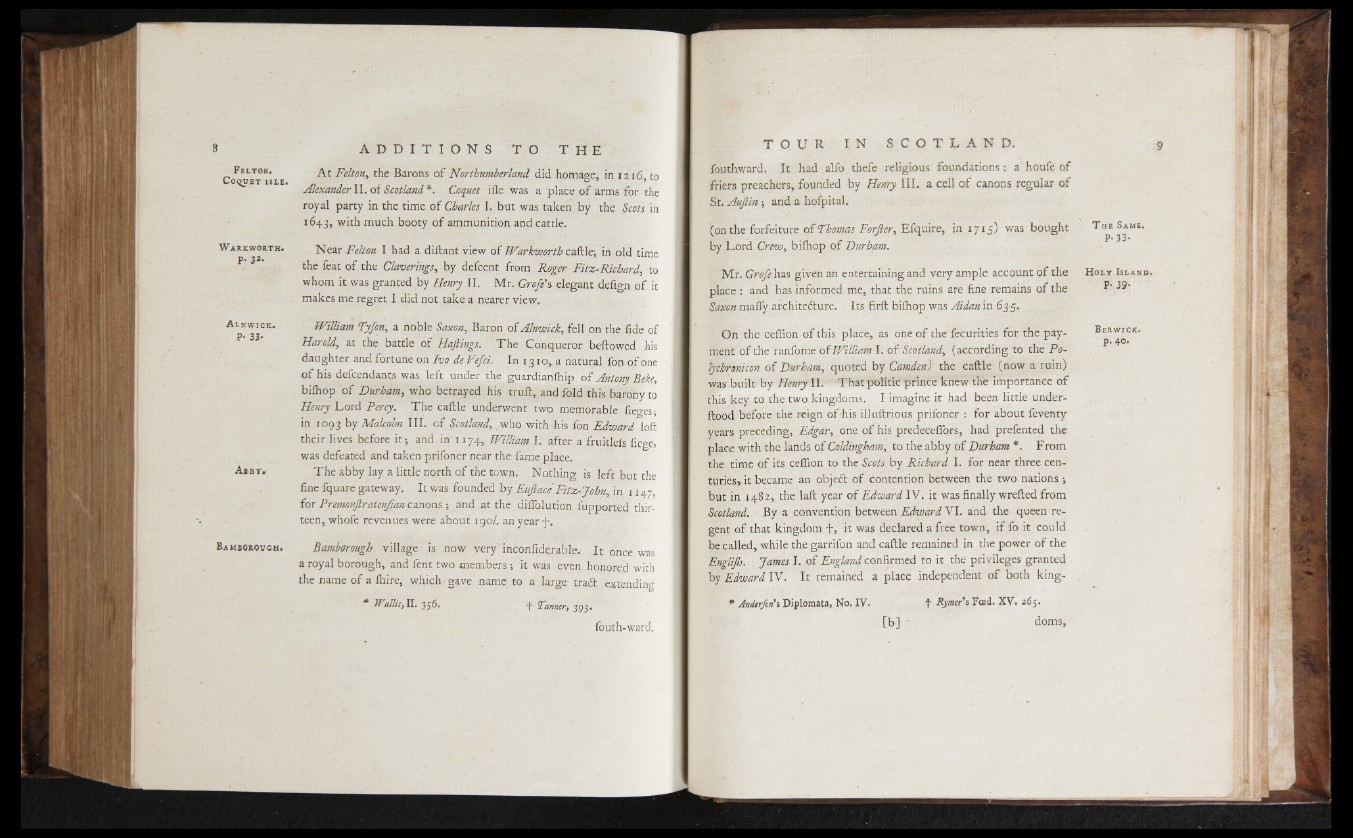
F elton.
C oque t is l e .
W a r k w o r t h .
p. 32.
A l n w i c k .
P- 33-
A e b y .
Bahborough.
At Felton, the Barons of Northumberland did homage, in 12 16 to
Alexander II. of Scotland *. Coquet ifle was a place of arms for the
royal party in the time of Charles I. but was taken by the Scots in
1643, with much booty of ammunition and cattle.
Near Felton I had a diftant view of Warkworth caftle; in old time
the feat of the Claverings, by defcent from Roger Fitz-Richard, to
whom it was granted by Henry II. Mr. Grofe’s elegant defign of it
makes me regret I did not take a nearer view.
William Tyfon, a noble Saxon, Baron of Alnwick, fell on the fide of
Harold, at the battle of Hajlings. The Conqueror bellowed his
daughter and fortune on h o de Vefci. In 1310, a natural fon of one
of his defcendants was left under the guardianihip of Antony Beke,
bilhop of Durham, who betrayed his trull, and fold this barony to
Henry Lord Percy. The caftle underwent two memorable fieo-es;
in 1093 by Malcolm III. of Scotland, who with-his fon Edward loft
their lives before it ; and in' 1174, William I. after a fruitlefs fiege,
was defeated and taken prifoner near the fame place.
The abby lay a little north of the town. Nothing is left but the
fine fquare gateway. It was founded by Euftace'Fitz-John, in 1147,
for Premonjlratenjian canons ; and - at the diflolution fupported thirteen,
whofe revenues were about 190/. an year-f.
Bamborough village is now very inconfiderable. It once was
a royal borough, and fent two members ; it was even honored with
the name of a Ihire, which gave name to a large trail extending
* Wallis, II. 356. 4 Tanner, 393.
fouth-ward.
fouthward. It had alfo thefe religious foundations : a houfe of
friers preachers, founded by Henry III. a cell of canons regular of
St. Auftin ; and a hofpital.
(on the forfeiture of Thomas Forfier, Efquire, in 1715) was bought The
by Lord Crew, bilhop of Durham.
Mr. Grofe has given an entertaining and very ample account of the H o l y Is land.
place : and has informed me, that the ruins are fine remains of the p
Saxon mafly architecture. Its firft bilhop was Aidan in 635.
On the cefiion of this place, as one of the fecurities for the payment
of the ranfome of William I. of Scotland, (according to the Po-
lychronicon of Durham, quoted by Camden) the caftle (now a ruin)
was built by Henry II. That politic prince knew the importance of
this key to the two kingdoms. I imagine it had been little under-
ftood before the reign of his illuftrious prifoner : for about feventy
years preceding, Edgar, one of his predecelfors, had prefented the
place with the lands of Coldingham, to the abby of Durham *. From
the time of its cefiion to the Scots by Richard I. for near three centuries,
it became an objeft of contention between the two nations •,
but in 1482, the laft year of Edward IV. it was finally wrefted from
Scotland. By a convention between Edward VI. and the queen regent
of that kingdom +, it was declared a free town, if fo it could
be called, while the garrifon and caftle remained in the power of the
Engltfh. James I. of England confirmed to it the privileges granted
by Edward IV. It remained a place independent of both king-
* Andtrfin'% Diplomats, No. IV . f Rymer*s Feed. X V . 265.
B e rw i c k .
p . 40.
[ b ] doms,